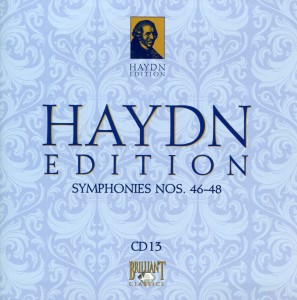 I decided to shake things up this morning.
I decided to shake things up this morning.
Instead of dining at the Panera farther away from where I live, I chose the Panera closer to me.
And instead of a booth, today I occupy that same square table I used to race to possess every day at 6:00am when I listened to the complete works of Mozart a couple of years ago.
Ooh. Big changes afoot.
 I dunno. May not seem like much to you. But if I was a cat I’d freak out at such major alterations to my schedule.
I dunno. May not seem like much to you. But if I was a cat I’d freak out at such major alterations to my schedule.
I listened to the following three symphonies (twice!) on CD 13 this morning:
Symphony No. 46 in B, which Haydn composed in 1772 during his Sturm und Drang period. He was 40 years old.
This symphony was gripping from the start. I liked it.
Here’s an interesting factoid about Symphony No. 46 in B from Wikipedia:
In Haydn’s time, this symphony required the use of horns crooked in B. Except for period instrument performances, the horn players now use valve horns, and perform the transposition from horns in B to horns in F or B-flat in their minds. However, as late as 1976, in all recordings available at the time, the players read their parts as if for horns in B basso rather than B alto.
Symphony No. 47 in G was stirring; at least, Movement I (“Allegro”) was. Movement II (“Un poco adagio, cantabile”), however, seemed interminable. It was a dirge to my ears. Movement III (“Menuet & Trio”) was typically lively and fun. The last movement (“Finale: Presto assai”), didn’t fulfill the promise begun by Movement I. But the hell do I know? I’m just a guy sipping Light Roast coffee in a cozy restaurant in West Michigan. I’m not slaving away by candlelight in late 1700s Europe, crafting a piece of music others would still listen to nearly three centuries later.
Symphony No. 47 was “probably” composed in 1772, which means Haydn would have been 40.
Symphony No. 48 in C “Maria Theresia” has in interesting history behind it. According to its entry on Wiki:
The work has the nickname Maria Theresia as it was long thought to have been composed for a visit by the Holy Roman Empress, Maria Theresa of Austria in 1773. An earlier copy dated 1769 was later found, but the nickname has stuck. The symphony composed for the empress’s visit was most likely No. 50.
Movement I opens with great fanfare, a stirring and fun interplay of instruments that sounds both royal and respectful. So I can see how people would think this was composed for Maria Theresia. Unlike Symphony No. 47, the final movement (“Finale: Allegro”) of this symphony pays off. It has the same triumphant tone that Movement I did.
Symphony No. 48 was composed in 1768 or 1769, making Haydn either 37 or 38 years old.
Panera is starting to fill up with the post-church brunch crowd. Lots of families, complete with chatty little kids.
Time for me to change my location entirely.

Horn players take particular pride in their ability to transpose from multiple keys on the fly. Try telling a trumpet or trombone section to do that, and they lose their minds or have to write in the notes. But horn players take it all in stride.